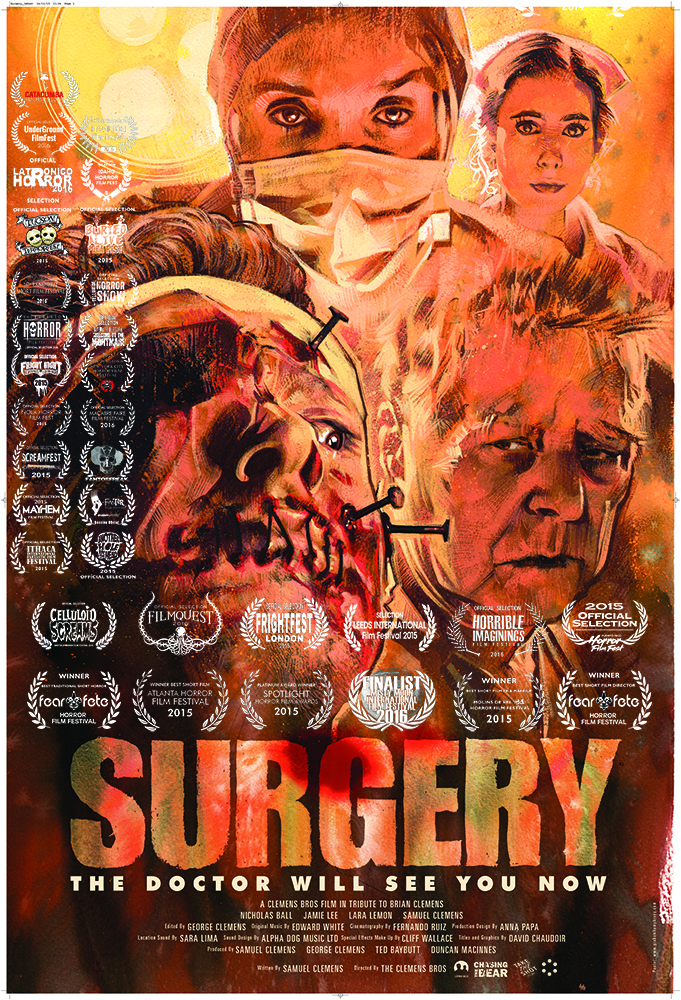
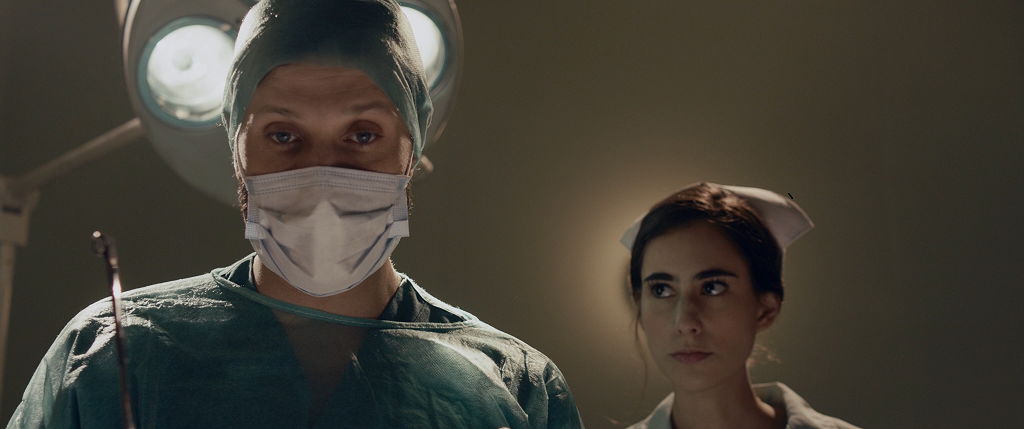
At A Glance
The scalpel is back out as the spine tingling short film Surgery is relaunched on YouTube. We interview writer and co-director Sam Clemens as we explore the making of the film.

Film Details
Directed by George Clemens, Samuel Clemens
Written by Brian Clemens, Samuel Clemens
2015, 11 minutes
Available Via YouTube from 31st July, 2020
Social Media @TakeTheShotLtd #SurgeryFilm
Cast
Nicholas Ball as The Crude Surgeon
Jamie Lee as Michael Shaw
Lara Lemon as Nurse
Samuel Clemens as Doctor
Many horrors use a lot of quick cutting, we don’t, it is the opposite the camera lingers and forces the viewer to watch. Reveals Writer and co-director Sam Clemens
By Claire Bueno
Contains spoilers
Surgery is based off a concept idea of The Avengers, The Professionals and The Golden Voyage of Sinbad writer Brian Clemens, can you share a little more about that?
We were in the process of writing a horror feature called The Still and George and I thought it would be a good idea to make a horror short to prove we could direct a good horror film. We were sat having lunch in a pub somewhere near our family home, discussing this prospect with our dad and he thought it was a sensible idea. So, we said ‘We really need a good idea, and want to use that long barn near the house if possible any thoughts?’ He pondered for about a minute and said ‘Yeah, how about this?’ and proceeded to pitch us the general idea of what became Surgery. It was a little different than what we ended up with but the essential idea of someone being tied up and operated on not knowing why or who was doing this to them. I remember we both looked at dad and said ‘Dad that’s horrible, let’s do that!’ It seemed so shocking an idea that even at the idea stage it made us both recoil, so surely if filmed the audience would have an equally if not more visceral reaction. That was around November/December time and George and I were quite busy with other commitments so couldn’t pursue it straight away. Sadly, our father passed away on the 10th of January the following year which shook both our worlds immensely, upending any work plans we had and family became the main focus. We were immediately contacted by the press and then began a swarm of interviews and discussions about dad, his work and his life days after the event. Rather than shy away from it, we both leaned into to it to celebrate him as much as possible and draw attention to just how brilliant a writer he was and how wonderful and kind a human being he was. Feeling we wanted to celebrate him in our own way, we thought it fitting that we make the very last artistic idea he ever had, which turned out to be Surgery. Given there is almost an alternative career’s worth of material unmade, alongside his produced work we felt making the last idea would be special, even if it was quite twisted. But then, he was a master of the thriller and was a real afficionado on crime and serial killers. He had a deep fascination with them and had read hundreds of books on the subject, plus his directorial debut, a Hammer Horror film Captain Kronos – Vampire Hunter was filmed in the same location, as was an episode of The Avengers entitled ‘Noon Doomsday’ starring Patrick Macnee and Tara King, we felt it fitting to add to the canon of work shot there.
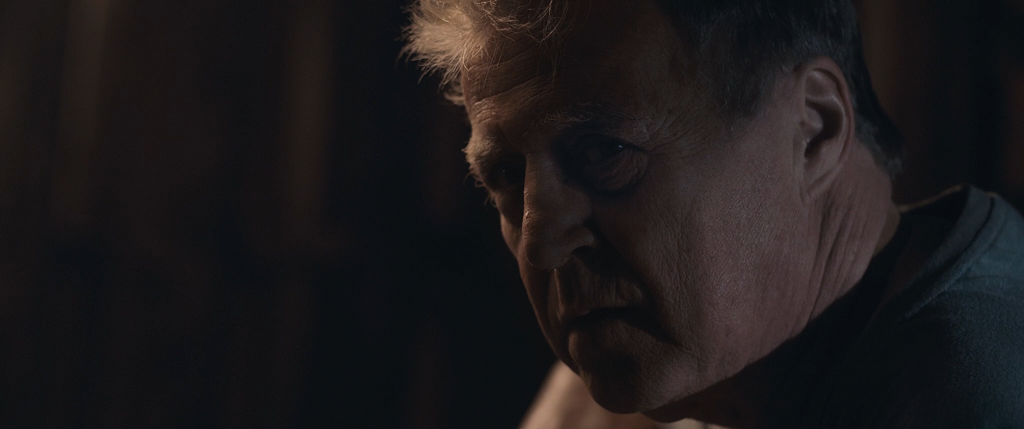
From concept, how did you develop Surgery?
The earliest concept before dad’s idea was to film in the long barn close to our family home. As kids we had played around it, as it was always locked and we had always wanted to shoot something there as it is so long, creepy and isolated, so that was the spring board for the whole thing, the location. Once dad’s idea was formed and now rooted in our minds, I set about writing a script. The original idea had The Doctor & Surgeon be the same person but we felt it was too gimmicky and unless the make-up was truly remarkable you would know it was the same person, so decided to change that part and make it a family affair. We put some money together to start the process but not enough to finish it but went ahead with the belief that we would raise the rest crowd funding, which thankfully we did! (That is an entirely another story). That belief that we would do it got everyone else on board. When we decided to make it, we shot it three and a half weeks later. With an enormous amount of love, help and support from all the collaborators we got it done but every day was terrifying as we were fighting so hard to meet the deadline. We had such a short window as I was off to act in a play abroad after it and given the post time needed, we wanted it ready to be able to submit to FrightFest, which we did and again luckily, we were accepted into the festival. The concept evolved and fine-tuned as the weeks went on and I kept making little adjustments to the script but fundamentally the very first script I wrote, 90% of it was the final film.
There is such an emotive twist at the end, and for me the genius behind the story is the power of perception, was that something that was a motivation for you?
We worked backwards from the twist. We knew that was the heart of the film. The film becomes a why done it? But in order for that to work you need to send the audience down a different path so they are not thinking in any way that it is really a thriller, wrapped up in a horror. Most of our work we subsequently have learned also uses this premise. I think we both like to be kept guessing as audience members and this translates to our sensibilities as directors and what I like to write. In this new world of social media and attention spans becoming shorter and shorter, now we have the ad for the teaser of the trailer which is like ten seconds, it is increasingly difficult to grab an audience’s attention and we think a good way to retain interest is to build intrigue and lay breadcrumbs for an audience to be able to participate as well as come along for the ride. Every character must have a reason for what they do, we as humans are motivated by wants, we always want something, we never want nothing, which frees you to create strong objectives for your characters as well. The stakes should always be high, or at least feel high for the characters, that is what keeps us interested. So the ending becomes a pay off for what has gone before and the last shot, which is one shot with no cuts we designed to be that long for the audience to process all they have just watched and give a sense of catharsis to the whole piece.
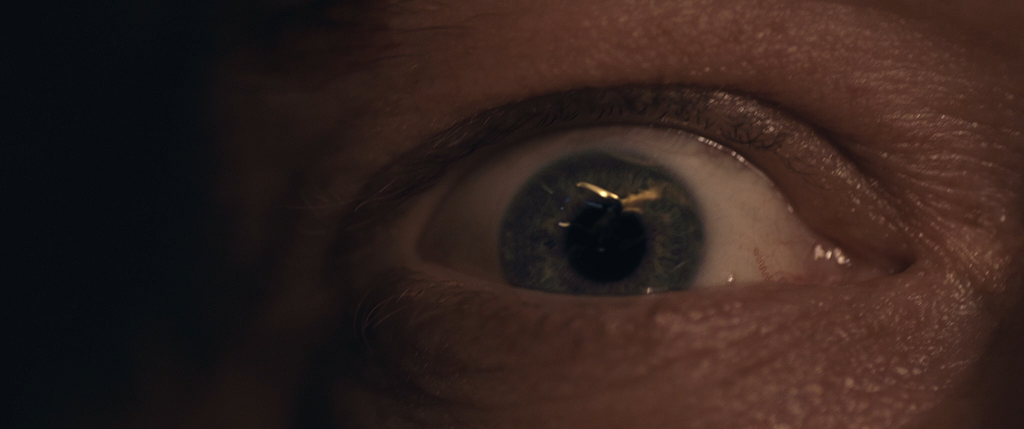
I imagine with horror the burning question is always what to show vs what not to show. Surgery really does strike the balance between the two, was that something that you carefully considered?
Yes, is the short answer. We didn’t want this to be a torture porn film, although it skirts close to that assumption but we knew if the audience could endure it, the payoff would change their perception. One of the best horror films ever made is ‘Jaws’ and the reason it works is that you never see the shark. We were incredibly lucky to get the truly remarkable Cliff Wallace (Hellboy, Fury, Doctor Who, World War Z, 28 Day Later) to come on board to do the practical special effects make up and prosthetics. We had a limited budget so worked around what could be done and literally what Cliff had lying around his workshop of wonder and horror (severed limbs, creatures, heads, blood etc) that we could use. Also, the imagination is usually worse than what you show, so we used that to our advantage by setting up something horrible, cutting away and then the aftermath. The whole of Seven worked wonderfully well with the discovery of the bodies and your vivid imaginations populate the rest of the macabre events themselves. So, when discussing it with Cliff, we worked out what would look best and the most realistic and what was possible. Hiring great people and letting them do what they do best is always a great starting point. Also, gore for gores sake is never pleasant, it must have a point even if it tough to watch.
“We worked backwards from the twist. We knew that was the heart of the film. The film becomes a why done it?"
And for what you don’t show you have some artfully crafted sound design?
That is also the other ingredient, the sound of what is happening. Sometimes the sound of something feels worse and is a cheaper device than showing it and we think a better and less gratuitous way. In Psycho the knife stabs make it fell very violent, if you take them out it loses that impact. Again, with this device, the surgery itself we knew we could make very immersive and gruesome but from the characters perspective. The Doctor trying to operate has to struggle through the patient’s pain and the sound elongates that process making it a much more difficult watch, allowing the audience to fill in the blanks. The other part to this is that it was great fun making those sounds in the post process with our sound designer and composer Edward Patrick White many fruits and vegetables were harmed in the making of this film!
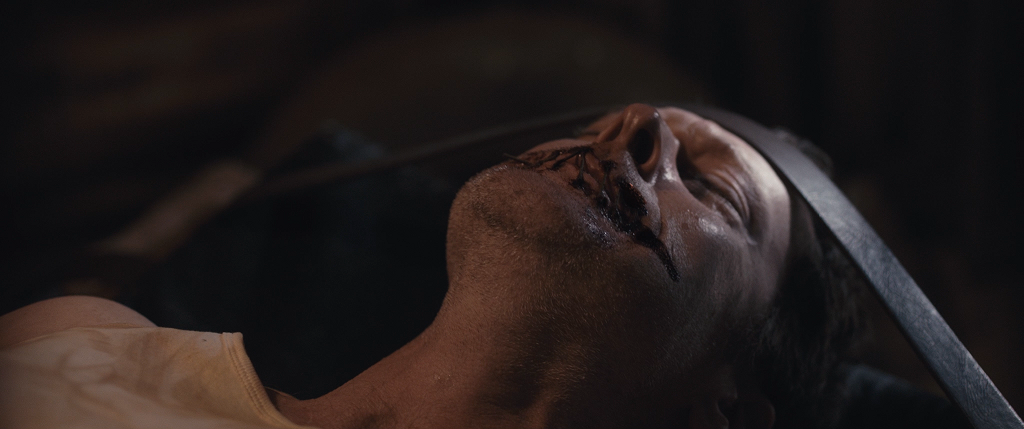
There’s a stunning noiresque look and feel to the film, the use of light and shadows really does benefit the aesthetic and whole atmosphere of Surgery, doesn’t it?
Well, that is down to our amazing DOP Fernando Ruiz who has a real style to his lighting and way of shooting. We have made many pieces together now and the way we work is that the camera has to be motivated by action, not the other way around. The scene itself tells you how it should be shot. We work with the actors and build the set ups around what we find in rehearsal, which is scary but very freeing and allows you to be very creative and fluid in your approach, rather than being stuck to your storyboards. However, from those discoveries it focusses the scene and allowed Fernando to be very precise and detailed within that fluidity. We wanted to create a sense of isolation and felt a combination of harsh light and shadow to reveal, objects, tools, clothing, shoes and characters helped build that tension as to what is going on, to the whys and who’s. Plus, there is a stark contrast in the lighting between the first half and the second half which helps retain the twist. In fact, Fernando has gone back to the film and remastered it, with tools that weren’t available to us on first release, so it looks even better and feels even more noiresque now.
Would I be mistaken if I says there’s also a small tribute to the Hammer films? 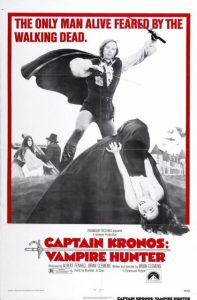
You would not be mistaken. As mentioned, Captain Kronos – Vampire Hunter was shot around the same location, and that was a Hammer Horror film production. We wanted to tip the cap to that genre but be true to our film at the same time. Many horrors use a lot of quick cutting, we don’t, it is the opposite the camera lingers and forces the viewer to watch. Dad wrote two Hammer Horror films, the one mentioned and Dr Jekyll & Sister Hyde so we have grown up around the genre and loved it, so felt fitting to use the same location as a tribute to what had gone before.
Because of the time constraints attributed to short film making, do you think it teaches us useful disciplines of keeping your story sharp and on point?
Absolutely, it forces you to adapt and quickly. The script was 10 pages and the film is 10 minutes with credits, so we were quite rigorous on keeping it tight. Our previous film left the gate at 22 minutes, which hurt it on the circuit as it was too long but impossible to cut it further without destroying the essence of the film, so we learnt the hard way once before, which taught us a valuable lesson, keep it short and to the point. With all the planning, VFX and difficult drone shot, (which starts inside, flies the whole length of the barn and then out for a mile and a half), we still had problems on the days filming. We had scheduled for about fifty set ups. On the first day it was clear we were not going to be able to do anywhere near this amount, so we decided to do long takes covering lots of action, and using the camera and blocking to create different frames. We might start in a wide, the actors moved into a mid and then into a close and back out to a wide. We would rack focus within scenes to build tension and divert the focus too. We ended up with about twenty-six set ups, so nearly half less! But it forced us to be more creative and trust our actors, DOP, operators and focus puller to make more interesting choices. This really was a team effort.
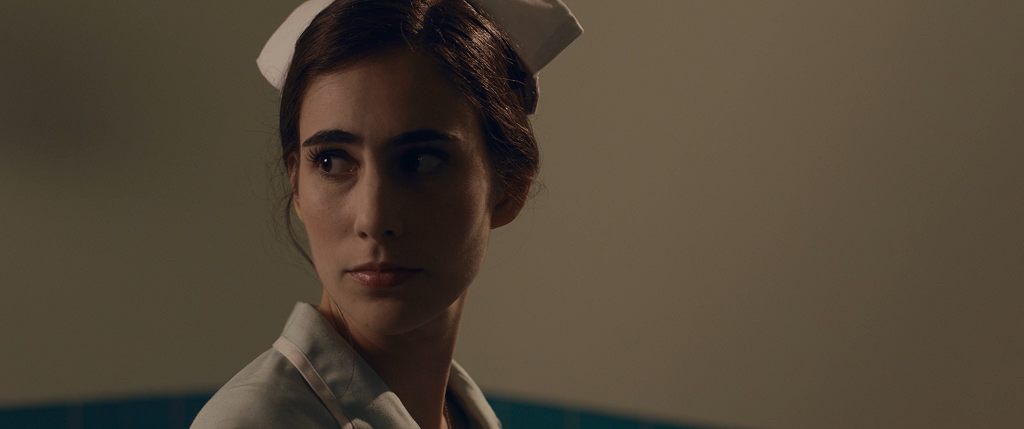
The film is being released on YouTube by Take The Shot Films. Can you tell us more about the production company and what you are hoping to achieve?
Take The Shot Films Ltd is a production services company that is a one stop shop for production and work flow from concept to delivery. We want to make socially relevant and conscious films, working with cutting edge technology to help reduce the carbon footprint of modern-day filmmaking, making all our productions “green”. The company is made up of six founding team members with the ability to write, produce, direct, and manage all aspects of production, with the equipment to shoot, edit, sound design, compose, mix, grade and deliver in house. We can provide these services to other external projects, whilst we also have a slate of in-house projects that we are currently developing. Fall from Grace is a female-centric Western, tackling stereotypes within the well-trodden genre for a new audience. On the Edge of Darkness a film adaptation of our father’s WW2 thriller play Strictly Murder, which I directed on a national stage tour in 2017. Concept trailer for On the Edge of Darkness will be coming out soon on our YouTube channel. Pride & Prejudice is a Docu-series, that explores the concepts of sexuality and gender identity in traditional societies around the globe as they continue to overcome the effects of a colonial past. The series will provide insight into the LGBTQ communities across India, Bermuda, and Canada. The Still a supernatural horror and our father’s last script, which we were writing together. We hope to make exciting films, that inspire, challenge and enthral, which have longevity, whilst being able to optimise the workflow by through cutting-edge technology from a Take The Shot Films Studio space.

Watch - Surgery
Claire hosts Surgery - Retrospective Cast and Crew Q&A
Social Media contacts
Take The Shot Films- @TakeTheShotLtd
Sam Clemens (Writer / Co-director / Actor) - @JoshTwain
George Clemens (Co-driectr / Editor) - @teamgeorge
Fernando Ruiz (DOP) - @FernandoRuizDOP
Edward Patrick White (Composer) - @EdwardPatrickW1
Agam Jain (Producer) - @AgamwithaG
Lara Lemon (Actress) - @Lara_Lemons
Sarah-Anne Grill (Production Manager) - @SarahAGrill
Cliff Wallace (VFX-Make Up / Prosthetics) - @cliffwallace
Take The Shot Films - @taketheshotltd
Sam Clemens (Writer / Co-director / Actor) - @samjtclemens
George Clemens (Co-Director / Editor- @tgproductions
Fernando Ruiz (DOP)- @fernandoruizdop
Edward Patrick White (Composer) @edward_patrick_white
Agam Jain (Producter) - @agam_with.a.g
Lara Lemon (Actress) - @lara_lemons
Sarah-Anne Grill (Production Manager)- @sarahagrill
Cliff Wallace(VFX-Make Up / Prosthetics - @creatfx
Anna Papa (Production Designer) - @annapapa_
Claire Bueno
Claire Bueno is a film journalist, presenter and interviewer, having moderated BAFTA, Royal Television Society (RTS), Women in Film and Television (WFTV), and Apple Store Q&As and hosted Comic Con panel talks. Claire is the founder of Premiere Scene Magazine and has had the privilege of interviewing esteemed artists including Tom Cruise, George Clooney, Brad Pitt, Sir Anthony Hopkins, Sigourney Weaver, Emily Blunt, Samuel L Jackson, James Cameron and Andy Serkis.
As a media coach Claire works with leading personal publicists, HBO, Netflix, Sky, ITV, Penguin Random House, the BFI, DDA, MacMillan and Premier, offering practical coaching sessions and safe environment for talent to perfect their interview technique before facing the press. She has extensive experience working with emerging and seasoned professionals and where English is not their first language.
Additionally, Claire is the producer of the critically acclaimed feature documentary CLEANIN’ UP THE TOWN: Remembering Ghostbusters and the upcoming TOO HOT TO HANDLE: Remembering Ghostbusters II.